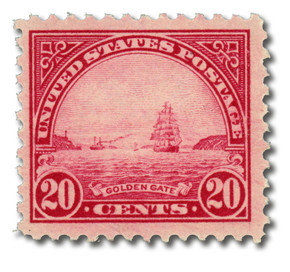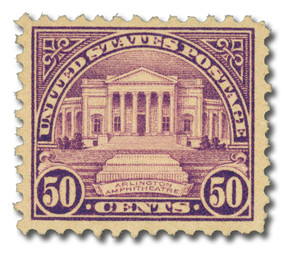
U.S. #562
Series of 1922-25 10¢ Monroe
Flat Plate Printing
Issue Date: January 15, 1923
First City: Washington, DC
Quantity Issued: 819,223,576
Printed by: Bureau of Engraving and Printing
Printing Method: Flat plate
Perforation: 11 gauge
Color: Orange
Although the Post Office Department made no official recognition of the 100th anniversary of the Monroe Doctrine, James Monroe was featured on this 10-cent stamp. It was issued on the centennial anniversary of his statement on foreign policy.
The Series of 1922-25
and the Wheels of Progress
In 1847, when the printing presses first began to move, they didn't roll they stamped in a process known as flat plate printing. The Regular Series of 1922 was the last to be printed by flat plate press, after which stamps were produced by rotary press printing.
By 1926, all denominations up to 10¢ except the new ½“ were printed by rotary press. For a while, $1 to $5 issues were done on flat plate press due to smaller demand.
In 1922, the Post Office Department announced its decision to issue a new series of stamps to replace the Washington-Franklin series, which had been in use since 1908. Many criticized the change, believing it was being made to satisfy collectors rather than to fill an actual need. However, the similar designs and colors of the current stamps caused confusion, resulting in a substantial loss in revenue each year. In busy situations, postal clerks could not tell at a glance if the correct postage was being used.
Postal employees requested a variety of designs which could easily be distinguished from one another. Great care was taken to make sure the new designs could not be confused. Although the frames are similar, the vignettes (central designs) are distinctive. Prominent Americans, as well as scenes of national interest, were chosen as subjects for the new series.
In addition to issuing new designs, the Department developed a plan to first distribute a small number of each stamp on a particular date in a selected town which was of historical and geographical significance to the subject. The plan greatly increased interest and began a new trend of collecting stamps on covers or envelopes postmarked on the first day of issue.
Washington Defeated At Brandywine
On September 11, 1777, George Washington's forces lost the battle of Brandywine.
In August 1777, the British fleet sailed down the east coast from New Jersey to Maryland. They landed about 50 miles from the American capital of Philadelphia, Pennsylvania, which they planned to capture.
Suspecting the British plans, General Washington positioned his forces between the two points, at Chadds Ford. He also had troops at several other nearby river crossings. Chadds Ford was the most direct route along the Brandywine River between Baltimore and Philadelphia, and Washington was sure thats where the British would attack.
However, the British didn't intend to attack the Americans at the center of their line. Instead, they set up a flanking maneuver and crossed the Brandywine Creek at points where Washington hadn't stationed men.
About 5:30 a.m. on September 11, under the cover of fog, British troops approached unsuspecting Americans stationed on the Great Road near the creek. The first battle of the day was fought there on the ground of a Quaker meetinghouse that continued their service despite the action outside. The battle continued throughout the morning, with the British reaching the American right flank around 2 p.m.
Fortunately for the Americans, the British attack was slow, giving them time to position troops on high ground. Soon the Americans had no choice but to withdraw. Major General John Sullivan and his men counterattacked, allowing part of the American line to retreat. Though reinforcements helped to delay the British advance for about an hour, they too were eventually forced to retreat. The Americans had to leave their cannons behind as most of their artillery horses had been killed.
Several famous military men participated in the Battle of Brandywine. The Marquis de Lafayette was wounded during the retreat. Future president James Monroe assisted Lafayettes physician because he spoke French. Henry Knox commanded the artillery while Anthony Wayne and Nathaniel Greene defended Chads Ford and Chads Ferry. During the retreat, Casimir Pulaski helped hold off the British forces. Other notable figures present at the battle included Alexander Hamilton, Light Horse Harry Lee, John Marshall, and Peter Muhlenberg.
The British attack ended at nightfall. A few small battles broke out in the coming days and the Americans then abandoned Philadelphia. The British occupied the city on September 26 and remained there until the following June.
According to legend, the Seventh Pennsylvania Regiment carried the unique Brandywine flag at the Battle of Brandywine. Referred to as a flag within a flag, the canton in the upper-left corner contained a 13-stripe and 13-star flag. The stars were arranged in three horizontal rows, and the top and bottom stripes were white. The remainder of the flag was red, perhaps a reflection of Washingtons own coat of arms.
See below for more stamps honoring notable figures from the Battle of Brandywine:















